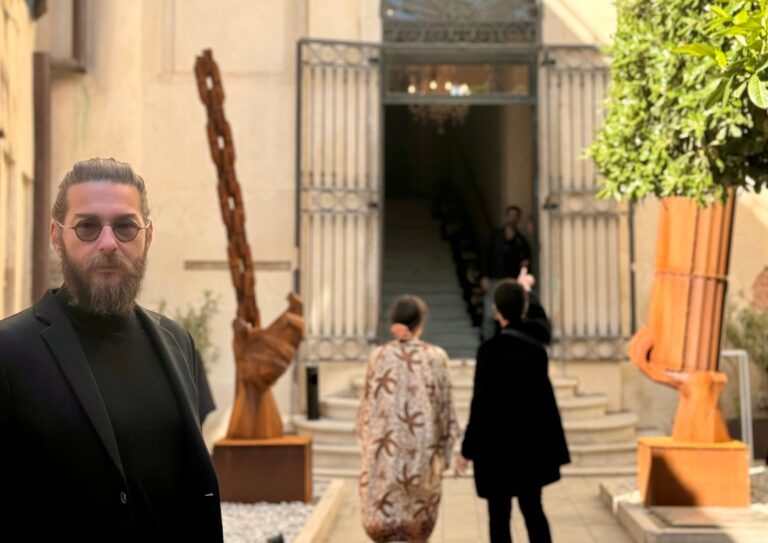
Nikola Vudrag at “Personal Structures — Beyond Boundaries”
Palazzo Mora, Venice, IT
Throughout his oeuvre—and in particular, over the past five years—each work is a reflection and a dynamic interplay of inner sensations and external conditions, revealing the turbulence that accompanies urban existence and societal expectations. Di’s solo exhibitions, like Mosquitoes Also Can Dream (2008) at DAD in Beijing, and his charitable contributions, such as For Children of China (2011) with the Amity Foundation in Shanghai, have established him as a notable figure within both local and international art contexts. His works have not only been featured in the art capitals of the world but also collected, as seen in his publication by Beijing Xiron Group (2013) and subsequent exhibitions such as Contrasts (2021) at Loosen Art Gallery in Rome and the Chengdu Biennale (2023).
Educated at the School of the Art Institute of Chicago, where he acquired his BFA and further honed at the University of Pennsylvania with an MFA, Di’s oeuvre stretches across multiple platforms. From interactive installations to computer graphics and from digital design to experimental games, his work consistently engages with a multimedia approach that is both experimental, ingenious, and sociocritical. At the core of Di’s artistic practice lies a deep interrogation of the human experience as it contends with the unyielding pressures of modernity. His art probes the dance between the self and society, where rapid societal changes spark existential uncertainties and the reassessment of cultural identities. Di challenges the perceptions of art as a solitary reflection by creating spaces of interaction that require more than passive observation. His art serves as an invitation to viewers to engage actively, to think, and to feel deeply, transforming spectators into participants.











Think of his interactive installations such as Hands Up Only (2022), a piece that borrows and appropriates from the everyday—yet loaded gesture: raising a hand. A simple raise of the hand can summon a variety of meanings. It’s a silent shout for attention, a humble admission of not knowing, a desperate plea for help. But let’s twist the kaleidoscope and focus through the lens of contemporary China; what does it mean to raise a hand there? What can it signify in a land where the collective often overshadows the individual, where subtlety speaks louder than screams? This installation doesn’t just ask you to look; it dares you to participate, to raise your own hand. It’s a call to action, a sort of artistic activism that requires viewers to engage, to think, and to question not just the meaning of the gesture but the very implications of participating in it. It disrupts, challenges, and interacts.
Or what about Aurora II (2021), where we enter a world where the lines between man and machine blur into indistinct whispers of possibility. This interactive installation doesn’t just flirt with the future; it embodies it. Mannequin hands, poised like silent sentinels, spring to life at the mere hint of human presence. Triggered by motion sensors, they begin their dance across the keys, typing out messages from a realm where AI and human thought blend seamlessly—or do they? In an era drunk on the promises of artificial intelligence and brain-computer interfaces, this piece throws a stark light on the possible grand trade-offs. What do we gain, and, more importantly, what might we lose? Are we sprinting toward a future where our very essence is mechanized, where autonomy is ancient history?
By weaving connections between the viewer’s personal experiences and the thematic essence of his works, Di fosters a communal discourse that is both reflective and transformative. This notion of art as a bridge rather than a barrier is central to understanding Di Tian’s vision. He constructs his artworks not only for aesthetic contemplation but as vehicles for emotional and intellectual engagement, encouraging a dialogue that extends beyond the visual to touch the very essence of our contemporary condition.

Di Tian achieved a BFA in Art and Technology at the School of Art Institute in Chicago, the United States of America, followed by an MFA in Digital/New Media Art at the University of Pennsylvania. Notable exhibitions include presentations at the 56th Venice Biennial in Venice, Italy; the Chengdu Biennale in Chengdu, China; Loosen Art Gallery in Rome, Italy; Texiang Art Space in Chengdu, China; the Loo Zhongli Art Museum in Chongqing, China; the Changing Museum of Contemporary Art in Chongqing, China; the NL Enlai Art Museum in Beijing, China; the Hang Xiang Art Museum in Chongqing, China; 102 Art Museum in Chongqing, China; and the World Fair in Seoul, South Korea; among others. The artist has received various individual awards and scholarships, encompassing a scholarship at the University of Pennsylvania, the Bronze Award for the CADA Japan Conceptual Art Design Award, the Excellence Award in the Britain International Creative Competition, the Annual Artist Award in the 3rd Artists Summer Exhibition of Weihai, and the SAIC Merit Scholarship at the Art Institute of Chicago. His work has been featured in EveryArt, Invent, 1314 Design & Art Magazine, Chongqing Morning News, Art News Weekly, General Knowledge Magazine, Art Type Magazine, and more.
For more information, please consult Di Tian’s website here.
Last Updated on May 2, 2024

Palazzo Mora, Venice, IT

The Controversial Truth